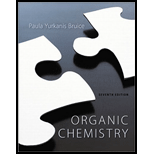
(a)
Interpretation:
The structure of the given compound (E)-Hydrazone of Benzaldehyde has to be drawn.
Concept introduction:
Imines can exists as stereoisomers. The isomers are named using the E, Z system of nomenclature. The lone pair has the low priority.
If the two high priority groups are on the same side of the double bond, then it is known as Z-isomer.
If the two high priority groups are on the opposite side of the double bond then it is known as E-isomer.
(b)
Interpretation:
The structure of the given compound (Z)-oxime of propiophenone has to be drawn.
Concept introduction:
Imines can exist as stereoisomers. The isomers are named using the E, Z system of nomenclature. The lone pair has the low priority.
If the two high priority groups are on the same side of the double bond, then it is known as Z-isomer.
If the two high priority groups are on the opposite side of the double bond then it is known as E-isomer.
Trending nowThis is a popular solution!

Chapter 17 Solutions
Organic Chemistry (Looseleaf) - With Access
- The reaction of a nitrile with an alcohol in the presence of a strong acid forms an N-substituted amide. This reaction, known as the Ritter reaction, doesnot work with primary alcohols. a. Why does the Ritter reaction not work with primary alcohols? b. Provide an explanation for why an amide is less susceptible to nucleophilic attack than its corresponding ester.arrow_forwardWhy do you wash the dichloromethane solution of your reductive amination product with sodium bicarbonate, rather than dilute aqueous HCl? a) Sodium bicarbonate is a good method of removing aldehydes from organic solvent.b) The amine product will be protonated by acid and remain in the aqueous layer as a salt.c) Sodium bicarbonate transfers the amine starting material into the aqueous layer.d) Sodium bicarbonate reacts with leftover NaBH(OAc)3 and removes it from the mixture.arrow_forward1. Why does H2 not give an IR spectrum? 2. Explain why primary amines and unsubstituted amides have two NH stretching absorptions. 3. Why do anhydrides show two carbonyl peaks? 4. HCl is known to give addition reactions to carbon-carbon double bonds. Why is this behavior not observed in this reaction? 5. Predict the structure of the product expected from addition of molecular bromine to maleic acid.arrow_forward
- Amino acids such as glycine are the building blocks of large molecules called proteins that give structure to muscle, tendon, hair, and nails. a.) Explain why glycine does not actually exist in the form with all atomsuncharged, but actually exists as a salt called a zwitterion. b.) What product is formed when glycine is treated with concentratedHCl?c.) What product is formed when glycine is treated with NaOH?arrow_forward1.draw the structure and write IUPAC name of furosemide 2. mention two most important medical uses of furosemide 3. identify and name all functional group present in furosemide 4. label chiral carbon atoms in furosemide 5.draw the structure of benzoic acid 6.name and draw the structure of all possible chemical ( electrophilic aromatic substitution ) reaction of benzoic acid a.Halogenation ( chlorination or bromination) b.nitration c.sulphonation d.friedal craft alkylation e.friedal craft acylationarrow_forward1) Redraw the structure and assign E or Z configuration to each double bond in the molecule. 2) Draw the organic products obtained from the ozonolysis of the compound, using a reductive work-up with zinc/HAc.arrow_forward
- 4-methoxybenzoic acid is less or more polar than 4-methoxyacetophenone? explain why (WITHOUT DRAWINGS)arrow_forwarda) Put these three common types of carbonyl compound in order of decreasing reactivity ester amide acid chloride b) For the least reactive, show the interconversion to its other resonance form: How does this electron delocalisation make it stable? c) For the most reactive, draw the mechanism of its undergoing hydrolysis (reaction with H2O): Why makes this type of carbonyl so reactive to nucleophiles?arrow_forward3′-chloro-4′-methoxyacetophenone is less or more polar than 4-methoxyacetophenone? explain why (WITHOUT DRAWINGS)arrow_forward
- Explain the effect of the structure of the alkyl halide on elimination through E1 and E2.arrow_forwardWhich or which of the statements given below is correct. I) Maleic anhydride is a carboxylic acid derivative and its reaction with water is a reduction reaction. II) Fumaric acid and maleic acid are stereoisomers of each other III) Since fumaric acid has a more stable structure than maleic acid, its boiling point is higher. A. Solo I B. I and III C. II and III D. I, II, III E. Solo IIIarrow_forwardSynthesis of p-Bromoaniline Why is the protection of the amine function needed in this reaction? a) The protection increases the selectivity for the ortho substitution. b) The protection increases the reactivity of the reactant in the bromination. c) The protection changes the regioselectivity of reaxtion.arrow_forward
 Organic Chemistry: A Guided InquiryChemistryISBN:9780618974122Author:Andrei StraumanisPublisher:Cengage Learning
Organic Chemistry: A Guided InquiryChemistryISBN:9780618974122Author:Andrei StraumanisPublisher:Cengage Learning Organic ChemistryChemistryISBN:9781305580350Author:William H. Brown, Brent L. Iverson, Eric Anslyn, Christopher S. FootePublisher:Cengage Learning
Organic ChemistryChemistryISBN:9781305580350Author:William H. Brown, Brent L. Iverson, Eric Anslyn, Christopher S. FootePublisher:Cengage Learning

